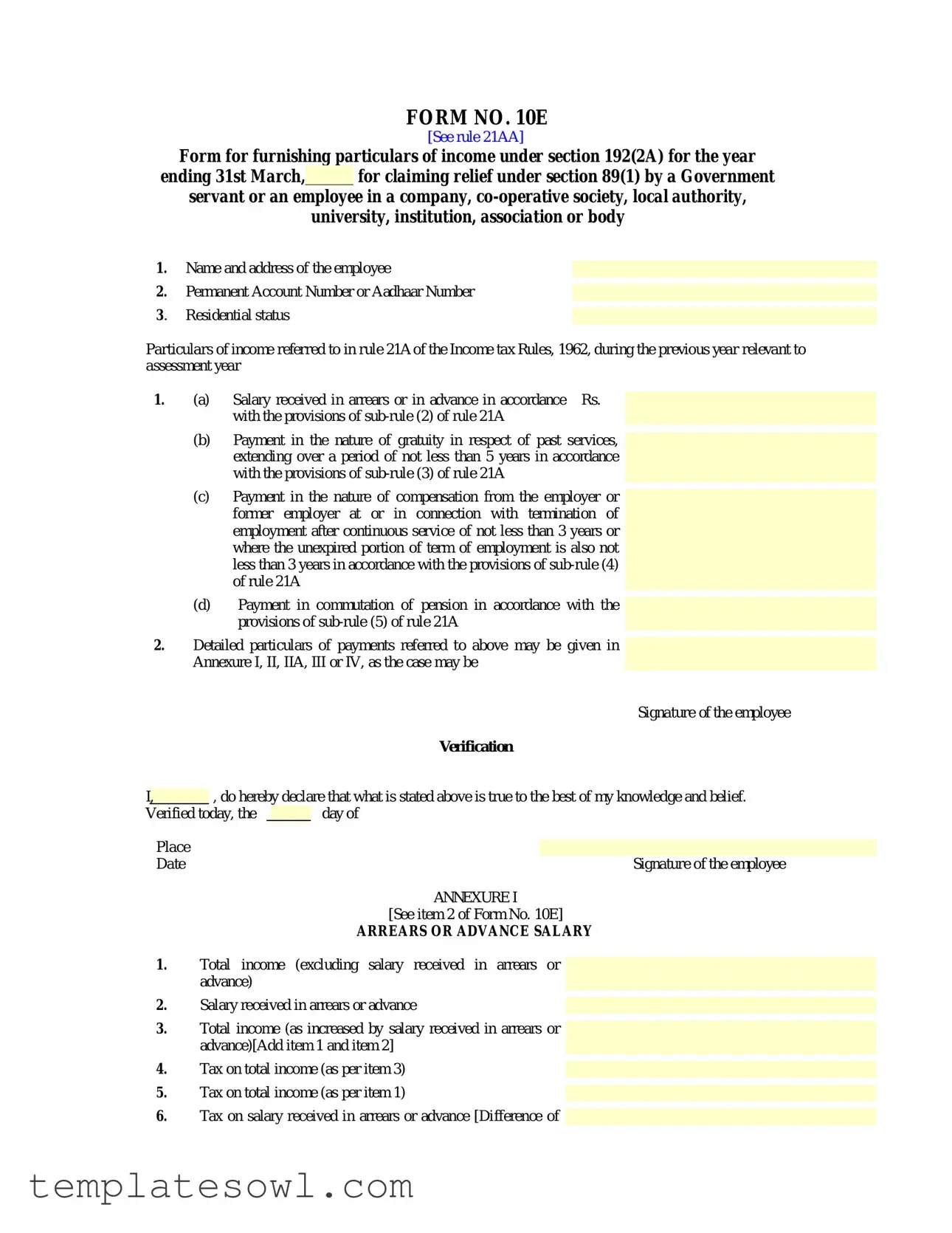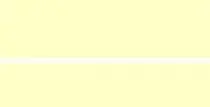FORM NO. 10E
[See rule 21AA]
Form for furnishing particulars of income under section 192(2A) for the year
ending 31st March, for claiming relief under section 89(1) by a Government
for claiming relief under section 89(1) by a Government
servant or an employee in a company, co-operative society, local authority,
university, institution, association or body
1. Name and address of the employee
2. Permanent Account Number or Aadhaar Number
3. Residential status
Particulars of income referred to in rule 21A of the Income tax Rules, 1962, during the previous year relevant to assessment year
1. |
(a) |
Salary received in arrears or in advance in accordance Rs. |
|
|
with the provisions of sub-rule (2) of rule 21A |
(b)Payment in the nature of gratuity in respect of past services, extending over a period of not less than 5 years in accordance with the provisions of sub-rule (3) of rule 21A
(c)Payment in the nature of compensation from the employer or former employer at or in connection with termination of employment after continuous service of not less than 3 years or where the unexpired portion of term of employment is also not less than 3 years in accordance with the provisions of sub-rule (4) of rule 21A
(d)Payment in commutation of pension in accordance with the provisions of sub-rule (5) of rule 21A
2.Detailed particulars of payments referred to above may be given in Annexure I, II, IIA, III or IV, as the case may be
|
|
|
|
|
|
|
|
Signature of the employee |
|
|
|
|
|
|
|
Verification |
|
I, |
|
, do hereby declare that what is stated above is true to the best of my knowledge and belief. |
|
|
|
|
|
|
|
day of |
|
Verified today, the |
|
|
|
|
|
|
Place |
|
|
|
|
|
|
|
|
|
|
|
|
Date |
|
|
Signature of the employee |
ANNEXURE I
[See item 2 of Form No. 10E]
ARREARS OR ADVANCE SALARY
1.Total income (excluding salary received in arrears or advance)
2. Salary received in arrears or advance
3. Total income (as increased by salary received in arrears or advance)[Add item 1 and item 2]
4. Tax on total income (as per item 3)  5. Tax on total income (as per item 1)
5. Tax on total income (as per item 1)  6. Tax on salary received in arrears or advance [Difference of
6. Tax on salary received in arrears or advance [Difference of 
item 4 and item 5]
7. Tax computed in accordance with Table "A" [Brought from column 7 of Table "A"]
8. Relief under section 89(1) [Indicate the difference between the amounts mentioned against items 6 and 7]
TABLE "A"
[See item 7 of Annexure I]
Previous |
Total income of |
Salary recieved in |
Total income (as |
Tax on total income |
Tax on total income |
Difference in tax |
|
year(s) |
the relevant |
arrears or advance |
increased by salary |
[as per column(2)] |
[as per column(4)] |
[Amount under column |
|
|
previous year |
relating to the |
received in arrears or |
|
|
(6) minus amount under |
|
|
|
relevant previous |
advance) of the |
|
|
column (5)] |
|
|
|
year as mentioned |
relevant previous year |
|
|
|
|
|
|
in column(1) |
mentioned in |
|
|
|
|
|
|
|
column(1) [Add |
|
|
|
|
|
|
|
columns (2) and (3)] |
|
|
|
|
|
(Rs.) |
(Rs.) |
(Rs.) |
(Rs.) |
(Rs.) |
(Rs.) |
|
1 |
2 |
3 |
4 |
5 |
6 |
7 |
|
|
|
|
|
|
|
|
|
|
|
|
|
|
|
|
|
|
|
|
|
|
|
|
|
|
|
|
|
|
|
|
|
Note : In this Table, details of salary received in arrears or advance relating to different previous years may be furnished.
ANNEXURE II
[See item 2 of Form No. 10E]
GRATUITY
Past services extending over a period of 5 years or more but less than 15 years
1. Gratuity received
2. Total income (including gratuity)
3. Tax on total income mentioned against item 2
4.Average rate of tax applicable on total income [Divide amount mentioned against item 3 by amount mentioned against item 2]
5.Tax payable on gratuity by applying the average rate of tax [Multiply average rate of tax mentioned against item 4 with amount of gratuity mentioned against item 1]
6.Total income of two previous years immediately preceding the previous year in which gratuity is received
(i)  (ii)
(ii) 
7.Add one-half of the gratuity mentioned against item 1 in the total income of each of the two preceding previous years mentioned against item 6
(i)  (ii)
(ii) 
8. Tax on total income of each of the preceding previous years mentioned against item 7
(i) 
(ii) 
9.Average rate of tax on the total income of each of the two preceding previous years as increased by ½ of gratuity calculated for that year as mentioned against item 7
[Divide the amounts mentioned against items 8(i) and 8(ii) by the amount mentioned against items 7(i) and 7(ii) respectively]
(i)  (ii)
(ii) 
10. Average of average rates of tax mentioned against item 9 [Add the averages of tax mentioned against items 9(i) and (ii) and divide it by 2]
11. Tax payable on gratuity by applying the average of average rates of tax [Multiply the average against item 10 by the amount of gratuity mentioned against item 1]
12.Relief under section 89(1) [Indicate the difference between the amounts mentioned against items 11 and 5]
ANNEXURE IIA
[See item 2 of Form No. 10E]
GRATUITY
Past services extending over a period of 15 years and more
1. |
Gratuity received |
|
2. |
Total income (including gratuity) |
|
3. |
Tax on total income mentioned against item 2 |
|
4. |
Average rate of tax applicable on total income [Divide |
amount |
|
mentioned against item 3 by amount mentioned against item 2] |
5. |
Tax payable on gratuity by applying the average rate of tax |
|
[Multiply average rate of tax mentioned against item 4 with |
|
amount of gratuity mentioned against item 1] |
|
6. |
Total income of three previous years immediately preceding the |
|
previous year in which gratuity is received |
(i) |
|
|
|
|
(ii) |
|
|
(iii) |
7. |
Add one-third of the gratuity mentioned against item 1 in the total |
|
income of each of the three preceding previous years mentioned |
|
against item 6 |
(i) |
|
|
|
|
(ii) |
|
|
(iii) |
8. |
Tax on total income of each of the preceding previous years |
|
mentioned against item 7 |
(i) |
|
|
|
|
(ii) |
|
|
(iii) |
9. |
Average rate of tax on the total income of each of the three |
|
preceding previous years as increased by one-third of gratuity |
|
calculated for that year as mentioned against item 7 [Divide the |
|
amounts mentioned against items 8(i), 8(ii) and 8(iii) by the |
|
amount mentioned against items 7(i), 7(ii) and 7(iii) respectively] |
|
|
(i) |
Total income (including compensation)
Tax on total income mentioned against item 2
(ii)  (iii)
(iii) 
10. Average of average rates of tax mentioned against item 9 [Add the averages of tax mentioned against items 9(i) to (iii) and divide it by 3]
11. Tax payable on gratuity by applying the average of average rates of tax [Multiply the average against item 10 by the amount of gratuity mentioned against item 1]
12.Relief under section 89(1) [Indicate the difference between the amounts mentioned against items 11 and 5]
ANNEXURE III
COMPENSATION ON TERMINATION OF EMPLOYMENT
Condition : After continuous service of three years and where unexpired portion of term of employment is also
not less than three years
1. Compensation received
2.
3.
4.Average rate of tax applicable on total income [Divide amount mentioned against item 3 by amount mentioned against item 2]
5. Tax payable on compensation by applying the average rate of tax [Multiply average rate of tax mentioned against item 4 with amount of compensation mentioned against item 1]
6.Total income of three previous years immediately preceding the previous year in which compensation is received
(i)  (ii)
(ii) 
(iii) 
7.Add one-third of the compensation mentioned against item 1 in the total income of each of the three preceding previous years mentioned against item 6
(i)  (ii)
(ii) 
(iii) 
8.Tax on total income of each of the preceding previous years mentioned against item 7
(i)  (ii)
(ii) 
(iii) 
9.Average rate of tax on the total income of each of the three preceding previous years as increased by one-third of compensation calculated for that year as mentioned against item 7 [Divide the amount mentioned against items 8(i), 8(ii) and 8(iii) by the amount mentioned against items 7(i), 7(ii) and 7(iii) respectively]
(i)  (ii)
(ii) 
(iii) 
10. Average of average rates of tax mentioned against item 9 [Divide by three, the total of averages of tax mentioned against items 9(i) to
Total income (including amount in commutation of pension) Tax on total income mentioned against item 2
(iii)]
11. Tax payable on compensation by applying the average of average rates of tax [Multiply the average against item 10 by the amount of compensation mentioned against item 1]
12.Relief under section 89(1) [Indicate the difference between the amounts mentioned against items 11 and 5]
ANNEXURE IV
COMMUTATION OF PENSION
1. Amount in commutation of pension received
2.
3.
4. Average rate of tax applicable on total income
[Divide amount mentioned against item 3 by amount mentioned against item 2]
5. Tax payable on amount in commutation of pension by applying the average rate of tax
[Multiply average rate of tax mentioned against item 4 with amount in commutation of pension mentioned against item 1]
6.Total income of each of the three previous years immediately preceding the previous year in which amount in commutation of pension is received
(i)  (ii)
(ii) 
(iii) 
7.Add one-third of the amount in commutation of pension mentioned against item 1 in the total income of each of the three preceding previous years mentioned against item 6
(i)  (ii)
(ii) 
(iii) 
8.Tax on total income of each of the preceding previous years mentioned against item 7
(i)  (ii)
(ii) 
(iii) 
9.Average rate of tax on the total income of each of the three preceding previous years as increased by one-third of the amount in commutation of pension calculated for that year as mentioned against item 7
[Divide the amount mentioned against items 8(i), 8(ii) and 8(iii) by the amount mentioned against items 7(i),7(ii) and 7(iii), respectively]
(i)  (ii)
(ii) 
(iii) 
10. Average of average rates of tax mentioned against item 9 [Divide by three, the total of averages of tax mentioned against items 9(i) to (iii)]
11.Tax payable on amount in commutation of pension by applying the average of average rates of tax
[Multiply the average against item 10 by the amount in commutation of pension mentioned against item 1]
12.Relief under section 89(1)
[Indicate the difference between the amounts mentioned against items 11 and 5]


 for claiming relief under section 89(1) by a Government
for claiming relief under section 89(1) by a Government



 (ii)
(ii) 
 (ii)
(ii) 



 (ii)
(ii) 

 (iii)
(iii) 
 (ii)
(ii) 

 (ii)
(ii) 

 (ii)
(ii) 

 (ii)
(ii) 


 (ii)
(ii) 

 (ii)
(ii) 

 (ii)
(ii) 

 (ii)
(ii) 

